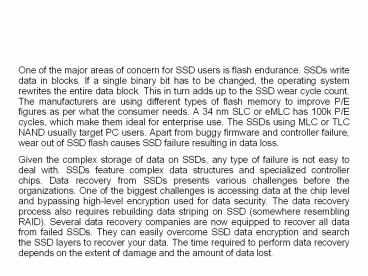A Closer Look at SSD Failure PowerPoint PPT Presentation
Title: A Closer Look at SSD Failure
1
- One of the major areas of concern for SSD users
is flash endurance. SSDs write data in blocks. If
a single binary bit has to be changed, the
operating system rewrites the entire data block.
This in turn adds up to the SSD wear cycle count.
The manufacturers are using different types of
flash memory to improve P/E figures as per what
the consumer needs. A 34 nm SLC or eMLC has 100k
P/E cycles, which make them ideal for enterprise
use. The SSDs using MLC or TLC NAND usually
target PC users. Apart from buggy firmware and
controller failure, wear out of SSD flash causes
SSD failure resulting in data loss. - Given the complex storage of data on SSDs, any
type of failure is not easy to deal with. SSDs
feature complex data structures and specialized
controller chips. Data recovery from SSDs
presents various challenges before the
organizations. One of the biggest challenges is
accessing data at the chip level and bypassing
high-level encryption used for data security. The
data recovery process also requires rebuilding
data striping on SSD (somewhere resembling RAID).
Several data recovery companies are now equipped
to recover all data from failed SSDs. They can
easily overcome SSD data encryption and search
the SSD layers to recover your data. The time
required to perform data recovery depends on the
extent of damage and the amount of data lost.
2
- One of the major areas of concern for SSD users
is flash endurance. SSDs write data in blocks. If
a single binary bit has to be changed, the
operating system rewrites the entire data block.
This in turn adds up to the SSD wear cycle count.
The manufacturers are using different types of
flash memory to improve P/E figures as per what
the consumer needs. A 34 nm SLC or eMLC has 100k
P/E cycles, which make them ideal for enterprise
use. The SSDs using MLC or TLC NAND usually
target PC users. Apart from buggy firmware and
controller failure, wear out of SSD flash causes
SSD failure resulting in data loss. - Given the complex storage of data on SSDs, any
type of failure is not easy to deal with. SSDs
feature complex data structures and specialized
controller chips. Data recovery from SSDs
presents various challenges before the
organizations. One of the biggest challenges is
accessing data at the chip level and bypassing
high-level encryption used for data security. The
data recovery process also requires rebuilding
data striping on SSD (somewhere resembling RAID).
Several data recovery companies are now equipped
to recover all data from failed SSDs. They can
easily overcome SSD data encryption and search
the SSD layers to recover your data. The time
required to perform data recovery depends on the
extent of damage and the amount of data lost.
3
- One of the major areas of concern for SSD users
is flash endurance. SSDs write data in blocks. If
a single binary bit has to be changed, the
operating system rewrites the entire data block.
This in turn adds up to the SSD wear cycle count.
The manufacturers are using different types of
flash memory to improve P/E figures as per what
the consumer needs. A 34 nm SLC or eMLC has 100k
P/E cycles, which make them ideal for enterprise
use. The SSDs using MLC or TLC NAND usually
target PC users. Apart from buggy firmware and
controller failure, wear out of SSD flash causes
SSD failure resulting in data loss. - Given the complex storage of data on SSDs, any
type of failure is not easy to deal with. SSDs
feature complex data structures and specialized
controller chips. Data recovery from SSDs
presents various challenges before the
organizations. One of the biggest challenges is
accessing data at the chip level and bypassing
high-level encryption used for data security. The
data recovery process also requires rebuilding
data striping on SSD (somewhere resembling RAID).
Several data recovery companies are now equipped
to recover all data from failed SSDs. They can
easily overcome SSD data encryption and search
the SSD layers to recover your data. The time
required to perform data recovery depends on the
extent of damage and the amount of data lost.
4
A Closer Look at SSD Failure
- Binabot Review SSDs have emerged as a good
alternative to meet the high performance needs of
enterprises. However, when it comes to
reliability and endurance, they are not the best
option due to the wear out mechanisms that are
inherent to all devices based on flash
technology. Although SSDs (based on flash) are
non-volatile, they exhibit abnormal behavior in
times of power failures. A recent study by the
researchers of Ohio State University and HP Labs
brought to light five different types of failures
in SSDs when exposed to power faults shorn
writes, metadata corruption, bit corruption,
unserializable writes, and dead devices. - http//autobinarysignalssoftwarereviews.com/binabo
t-review-binabot-app-scam-or-legit/ - Integrated circuit assemblies are the only type
of memory employed in SSDs for storing data.
Since SSDs have no mechanical components as
opposed to HDDs, users can rest assured that
these drives are free of hardware damages like
head crashes. However, SSDs are not immune to
failures. The built-in flash chips may suffer
from physical damage. Other aspects of data loss
also apply to SSDs, such as viruses, human
errors, software conflicts, and more.

